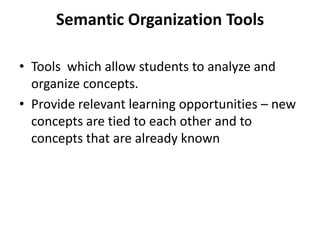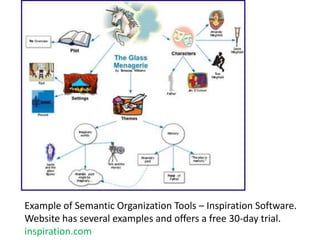semantic thinking tools
- 2. Semantic Organization ToolsTools which allow students to analyze and organize concepts. Provide relevant learning opportunities â new concepts are tied to each other and to concepts that are already known
- 3. Semantic Organization Tools2 main types of tools: 1. semantic networks/concept maps â learners draw visual maps of interrelated concepts ex. Spider map, word web, flow chart, Venn Diagrams 2. databases â electronic record-keeping and retrieval systems - Relational â allow several users to participate and link data simultaneously - Data can be formatted in various reports - greater storage capacity than spreadsheets alone
- 4. Example of Semantic Organization Tools â Inspiration Software. Website has several examples and offers a free 30-day trial. inspiration.com
- 5. Sample of student writing plan for a mythology story
- 6. Clicking on âeffectâ allows student to change adjectives describing the setting and characters. Scholastic.com
- 7. Concept Map â readwritethink.orgUsed to show relationships in most any content area:
- 8. between words and phrases
- 10. science concepts
- 11. historical events Concept WebsUsed to develop higher order thinking skills such as comprehension and synthesis
- 12. Students can generate words or teachers can give them the words to sort based on relationship.
- 13. Great for small groups or individuals
- 14. Students can present to class and explain their rationale for word placement and relationships between words
- 15. Use as a writing organizer - students can box off groups of words and use each group as a paragraph.
- 16. Use to show ideas and relationships about characters in a novel. Students can compare and contrast their maps.Steps in constructing concept mapsUsing Inspiration Software and the âSummary Manâ Template from The Visual Leap at www.thevisualleap.com
- 17. Steps in constructing concept mapsSelectFocus on a theme and then identify related key words or phrases. Franklin D. Roosevelt
- 18. Steps in constructing concept mapsRankRank the concepts (key words) from the most abstract and inclusive to the most concrete and specific.
- 19. Steps in constructing concept mapsClusterCluster concepts that function at similar level of abstraction and those that interrelate closely.
- 20. Steps in constructing concept mapsArrangeArrange concepts in to a diagrammatic representation. Link Link concepts with linking lines Created using Inspiration
- 22. DatabasesLink to use Excel for concept mappinghttp://www.internet4classrooms.com/excel_concept_map.htmThis link allows you to generate a concept map from information in a spreadsheet.
- 23. Database Assignment 6th grade Language ArtsStudents were placed in groups to complete research on 2 of 16 public colleges in NC using the following website/database http://www.collegeportraits.org/NCThey were given specific information to find and place in a spreadsheet. Other assignments involved generating maps and creating T-shirts and pennants to go with respective colleges. Then students completed an evaluative writing assignment at the conclusion stating what they had learned.The completed spreadsheet was made available for all students to see, thus allowing them to make comparisons.Graphs were also be generated from the spreadsheet.
- 24. Database/Spreadsheet - 16 Colleges in UNC System â each group of students was assigned to find and enter information for 2 colleges. Then all were compared and evaluated based on various criteria.
- 28. Synchronous ConferencingGoogle ChatAllows for online meeting
- 29. Convenient
- 30. Use inside of GMailBlogswww.cnnstudentnews.com
- 31. Current Events
- 32. Share opinions
- 33. Posts appear once they are approvedAsynchronous ConferencingGoogle Documents
- 34. VokiSample VokiAllows students to share thoughts through characters. Increases involvement
- 35. ReferencesThe Visual Leap:www.thevisualleap.comInspiration Softwarehttp://www.fed.cuhk.edu.hk/~johnson/misconceptions/concept_map/cmapguid.html
























